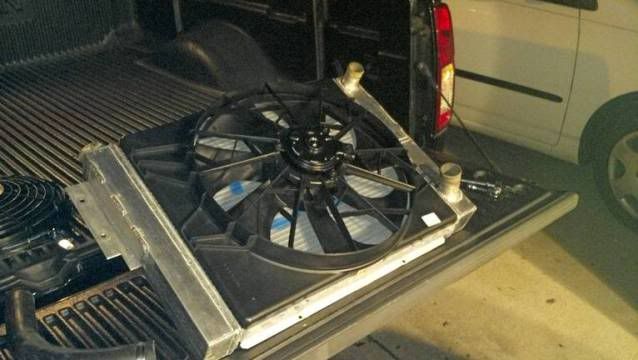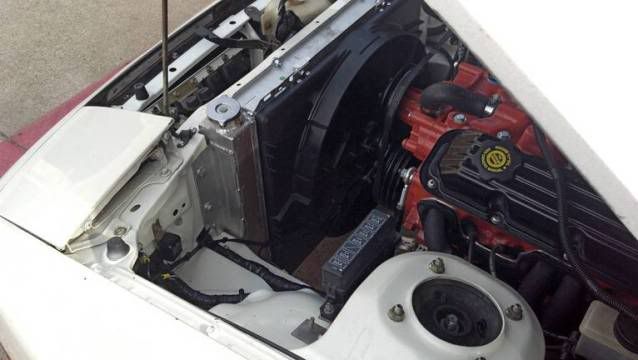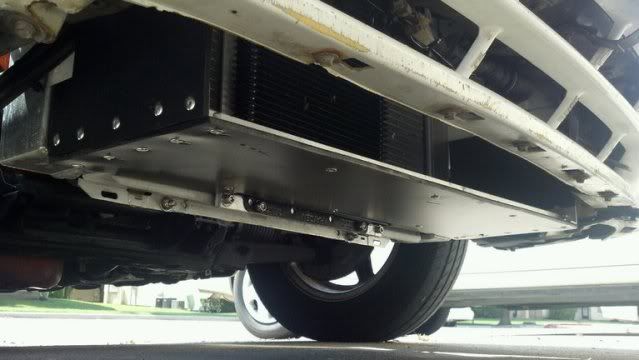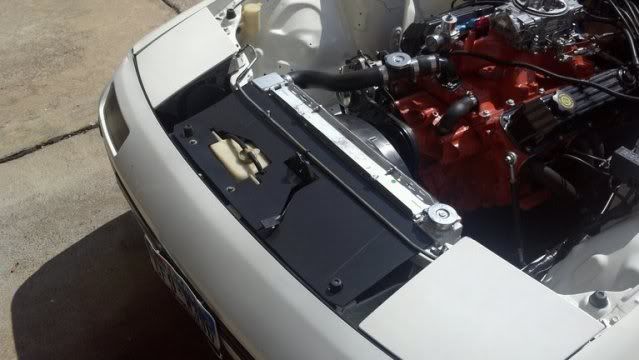UOP
Well-Known Member
Not an Abody, obviously, but maybe some of you guys can help me with persistant cooling problems ever since I put my car on the road.
Not trying to write a novel here but I'm out of ideas. My first setup was a 22x19 (core alone is larger than old radiator) 2 core aluminum radiator with your typical Flex-A-Lite 16" fan and it barely kept up. Anything over 90 degrees outside I was constantly checking the temp gauge and I had to make absolutely sure to never get stuck in traffic because it was sure to overheat. I completely boxed the entire area in front of the radiator and that made it ok when moving over 40 mph, but even then it ran above 200 degrees. Forget it on a 100+ degree day, it took highway speeds to keep it cool. Believe it or not I made it through Drag Week '12 this way, but was fortunate it was cool that week.
Last year I decided to revamp the whole system, cutting the car to install the biggest radiator that would fit between the frame rails, a 27x20 2 row double pass FSR radiator. I also installed new waterpump, thermostat, and installed a Lincoln Mark VIII 2 speed fan that's supposed to flow over 4000 cfm that covers the entire core. I thought I had it in the bag, but again once it gets hot outside, so does the motor. Running the fan on high in 100 degree heat still runs the gauge up to 210+ and I even had to stop in traffic once last year and open the hood to keep it from overheating. Embarassing. Again I've boxed the front to catch as much air as possible but it won't run at the 185 degree thermstat setting unless it's 75 degrees or less.
With the new setup it's ok running down the highway, but once I stop or get stuck in slow traffic, I'm getting nervous. Any ideas? I've tried all the water wetter additives, my headers are ceramic coated (used to be wrapped and almost ruined them), and the front of the radiator is sealed from the engine compartment. I don't particuarly want to cut hoes in my custom one-off hood but if that's what it takes then so be it.
One more thing, as I was writing this I remembered I don't have the heater lines hooked up. Could that be part of what's causing my problem? The heater core in the car leaks but maybe I could loop them? Heck, I'd even run the lines through a large trans cooler in the wheel well if that would help. I just need to get this under control before it gets hot again.
Appreciate it.
Not trying to write a novel here but I'm out of ideas. My first setup was a 22x19 (core alone is larger than old radiator) 2 core aluminum radiator with your typical Flex-A-Lite 16" fan and it barely kept up. Anything over 90 degrees outside I was constantly checking the temp gauge and I had to make absolutely sure to never get stuck in traffic because it was sure to overheat. I completely boxed the entire area in front of the radiator and that made it ok when moving over 40 mph, but even then it ran above 200 degrees. Forget it on a 100+ degree day, it took highway speeds to keep it cool. Believe it or not I made it through Drag Week '12 this way, but was fortunate it was cool that week.
Last year I decided to revamp the whole system, cutting the car to install the biggest radiator that would fit between the frame rails, a 27x20 2 row double pass FSR radiator. I also installed new waterpump, thermostat, and installed a Lincoln Mark VIII 2 speed fan that's supposed to flow over 4000 cfm that covers the entire core. I thought I had it in the bag, but again once it gets hot outside, so does the motor. Running the fan on high in 100 degree heat still runs the gauge up to 210+ and I even had to stop in traffic once last year and open the hood to keep it from overheating. Embarassing. Again I've boxed the front to catch as much air as possible but it won't run at the 185 degree thermstat setting unless it's 75 degrees or less.
With the new setup it's ok running down the highway, but once I stop or get stuck in slow traffic, I'm getting nervous. Any ideas? I've tried all the water wetter additives, my headers are ceramic coated (used to be wrapped and almost ruined them), and the front of the radiator is sealed from the engine compartment. I don't particuarly want to cut hoes in my custom one-off hood but if that's what it takes then so be it.
One more thing, as I was writing this I remembered I don't have the heater lines hooked up. Could that be part of what's causing my problem? The heater core in the car leaks but maybe I could loop them? Heck, I'd even run the lines through a large trans cooler in the wheel well if that would help. I just need to get this under control before it gets hot again.
Appreciate it.





















